In Hungary, winter wheat sowing ended in October. NDVI values were below average in mid-October and subsequently stayed above average. Agro-climatic indicators reveal that the area experienced average rainfall, above-average temperatures (+2.1°C), and below-average radiation (-1%). This resulted in a 10% increase in BIOMSS.
The Crop Production Index (CPI) in Hungary was 1.30. The national average VCIx was 0.99. Cropped arable land fraction (CALF) (90%) was higher by 10% as compared to its 5YA. The NDVI departure cluster profiles indicate that: (1) 33.2% of arable land experienced above-average crop conditions, scattered around Western Hungary, middle Hungary and Eastern Hungary. (2) 39.9% of arable land experienced above-average crop conditions in early October and late January, but was below average otherwise. It was scattered around all of Hungary. (3) 10% of arable land, mainly in middle Hungary and Eastern Hungary, had above-average crop conditions from November to January. The large drop in October might have been due to cloud cover in the satellite image. (4) 9.5% of arable land experienced below-average crop conditions from mid-November to January. (5) The NDVI of 7.3% of arable land fluctuated around the average. Altogether, the conditions for winter wheat in this period are assessed as slightly above average.
Regional analysis
Based on cropping systems, climatic zones and topographic conditions, Hungary is divided into four sub-regions: Northern Hungary (88), Central Hungary (87), the Great Plain (Puszta) (86) and Transdanubia (89). Specific observations for the reporting period are included for each region.
Central Hungary(87) is one of the major agricultural regions. A sizable share of winter wheat, maize and sunflower is planted in this region. According to the NDVI development graphs, NDVI values were below average in late October, early November and early December. In other periods, NDVI values were above average. Agro-climatic indicators show that rainfall (RAIN -8%) was below average. Temperature (TEMP +2.2°C) was above average. Radiation was average. BIOMSS had a 4% increase due to the adequate rainfall during this period. The VCIx was 1.05. Cropped arable land fraction (CALF) experienced a 6% increase compared to the 5YA. The CPI index was 1.30. The crop conditions in this region are slightly above average.
The Puszta(86) region mainly grows winter wheat, maize and sunflower, especially in the counties of Jaz-Nagykum-Szolnok and Bekes. According to the NDVI development graph, crop conditions were above average throughout the monitoring period. Despite a 7% below-average rainfall, the area experienced an increase in temperature of 2.3°C and above-average radiation of 1%, contributing to a 6% increase in biomass production. The maximum VCI was 1.01. CALF experienced a 17% increase compared to the 5YA. The CPI index was 1.38. The crop conditions in this region are slightly above average.
Northern Hungary (88) is a significant area for winter wheat production. According to the NDVI development graphs, NDVI values were below average in mid-October and mid-November. In other periods, NDVI values were above average. Agro-climatic indicators show that the rainfall was below average (-2%). The temperature was above average (TEMP +2.1°C), whereas radiation was below (RADPAR -1%), which resulted in above-average biomass (BIOMSS +7%). The maximum VCI was 1.04. CALF experienced a 10% increase compared to 5YA. The CPI index was 1.36. The crop conditions in this region are above average.
Southern Transdanubia (89) cultivates winter wheat, maize, and sunflower, mostly in Somogy and Tolna counties. Crop conditions were below average throughout the monitoring period. Rainfall and temperature were above average (RAIN +7%, TEMP +2.0°C), whereas solar radiation was below average (RADPAR -2%) and biomass was above average (BIOMSS +15%). The maximum VCI was favorable at 0.94. CALF experienced a 4% increase compared to the 5YA. The CPI index was 1.15. The crop conditions in this region are above average.
Figure 3.18 Hungary's crop condition, October 2022-January 2023

(a). Phenology of major crops
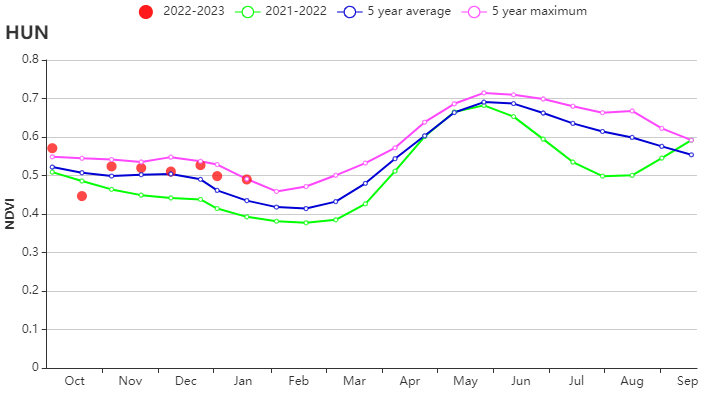
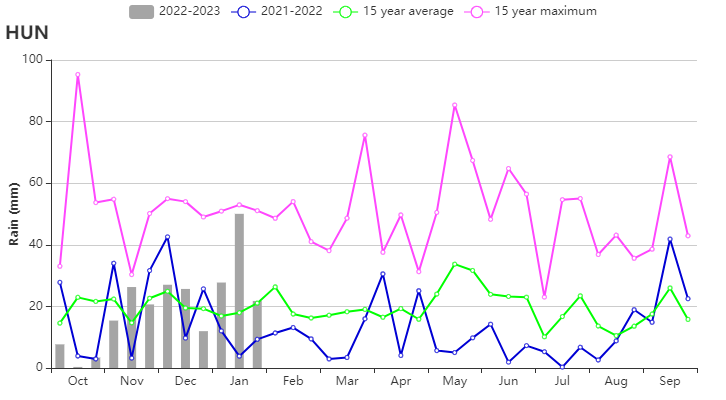

(b). Crop condition development graph based on NDVI, RAIN and TEMP (Hungary).
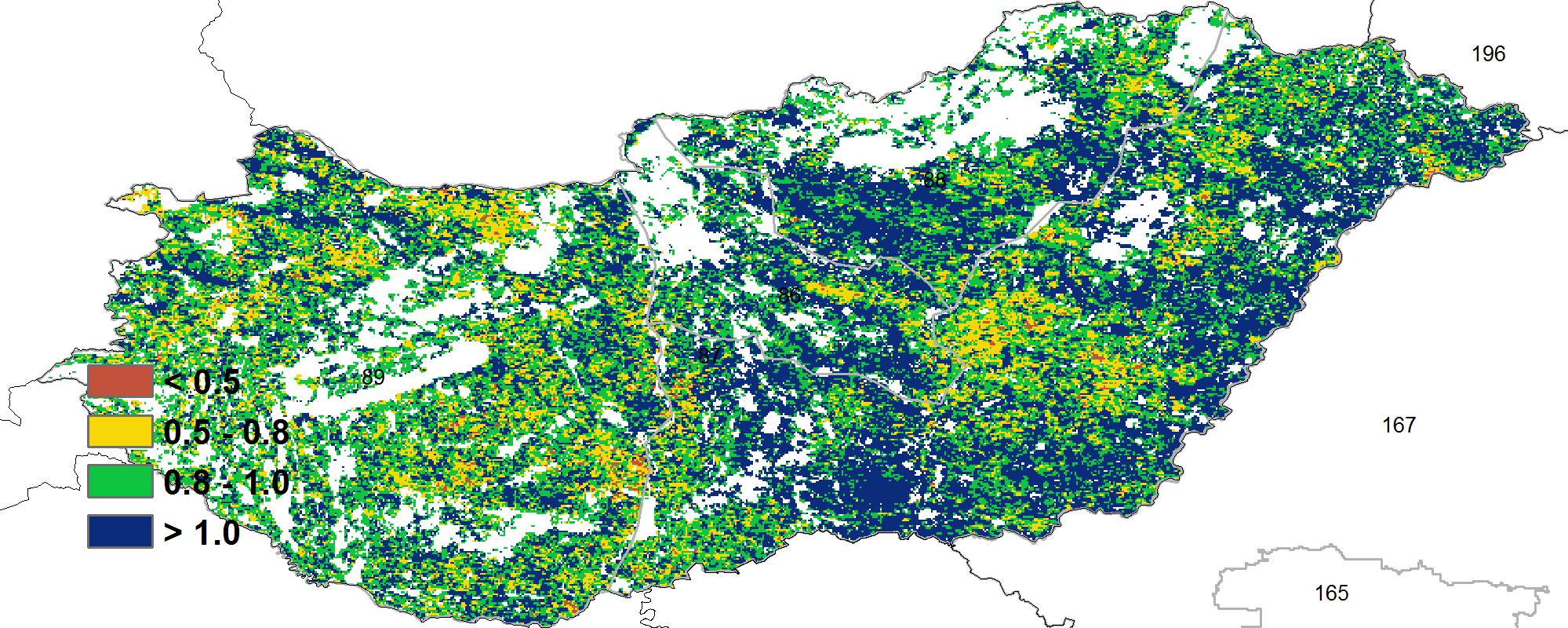
(c). Maximum VCI

(d). Spatial distribution of NDVI profiles.
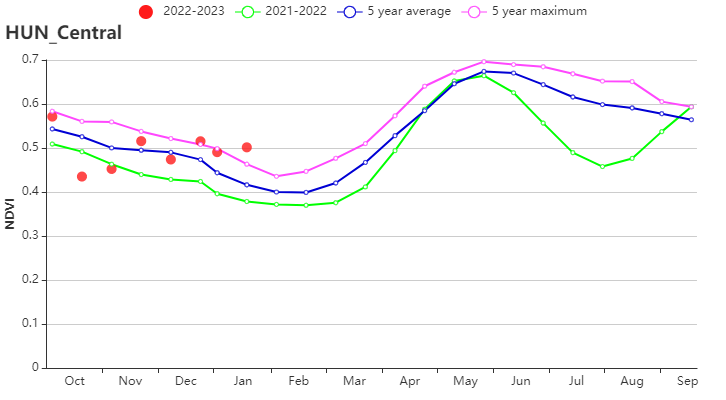
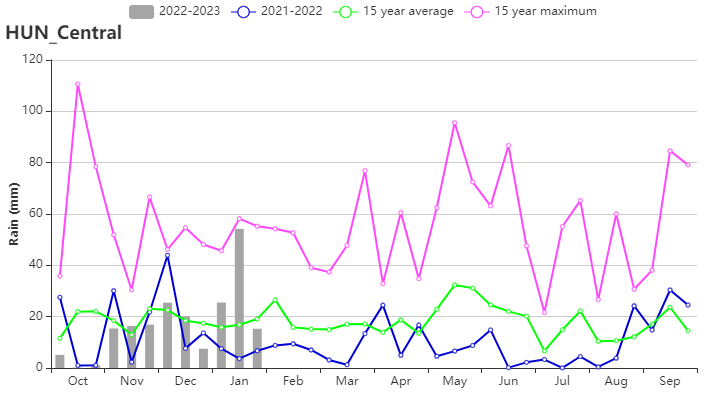
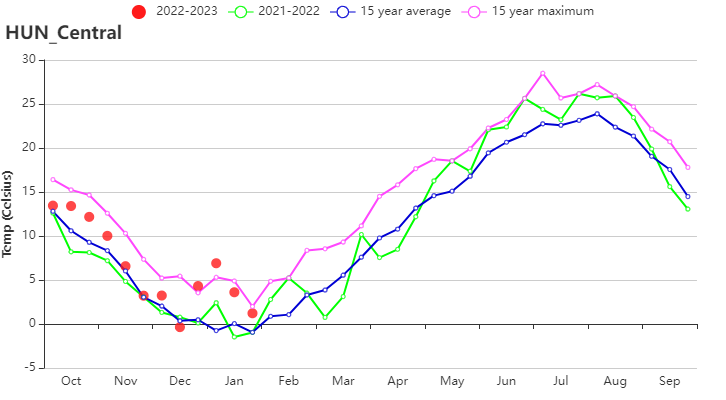
(e). Crop condition development graph based on NDVI, RAIN and TEMP (Central Hungary).
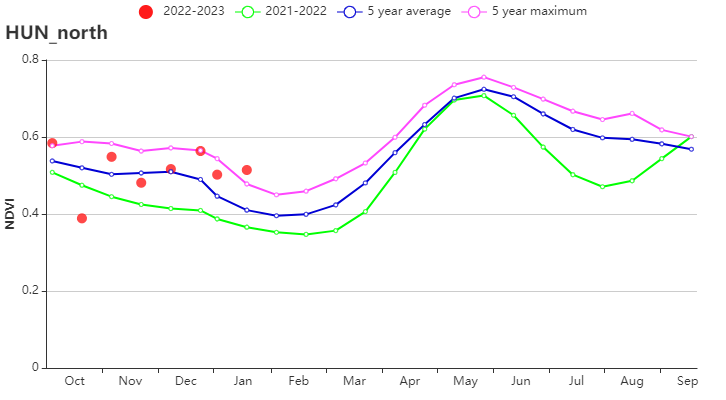
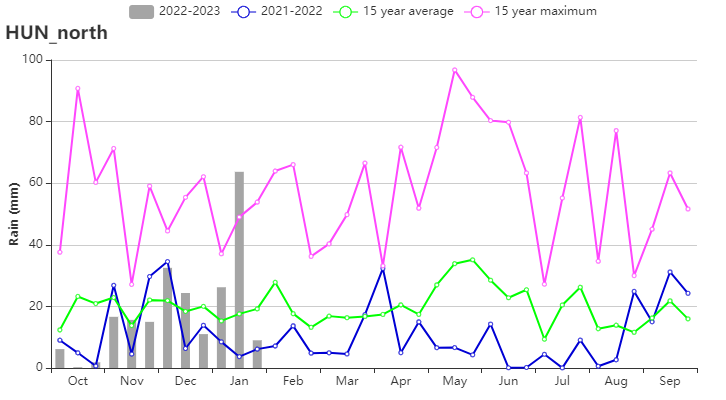
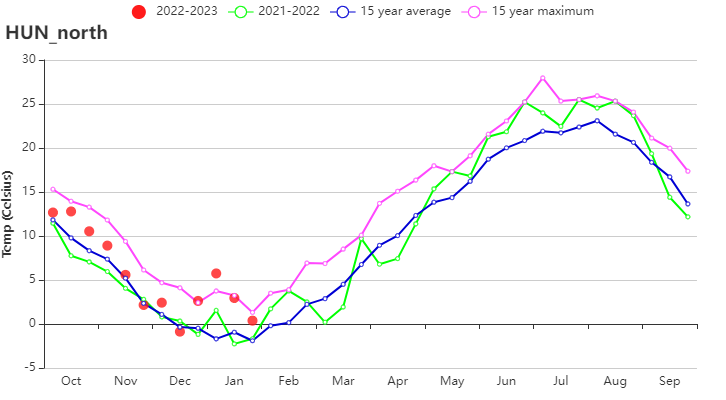
(f). Crop condition development graph based on NDVI, RAIN and TEMP (North Hungary).
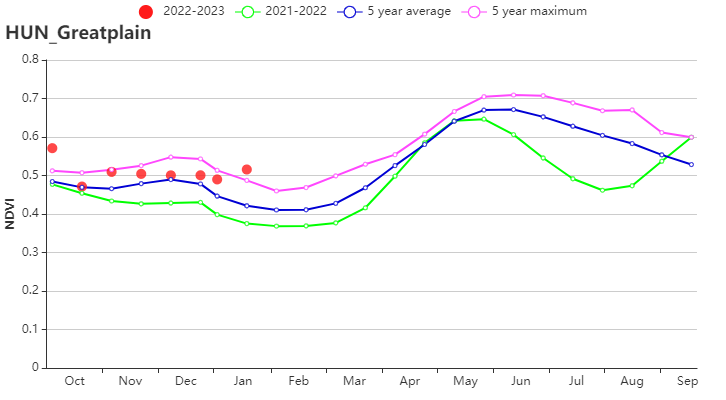

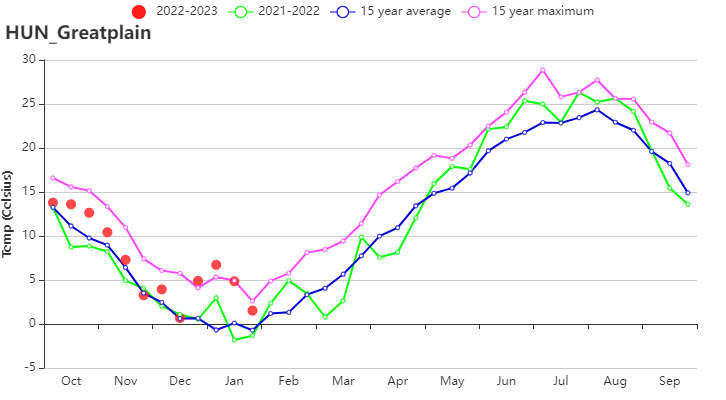
(g). Crop condition development graph based on NDVI, RAIN and TEMP (Great plain).
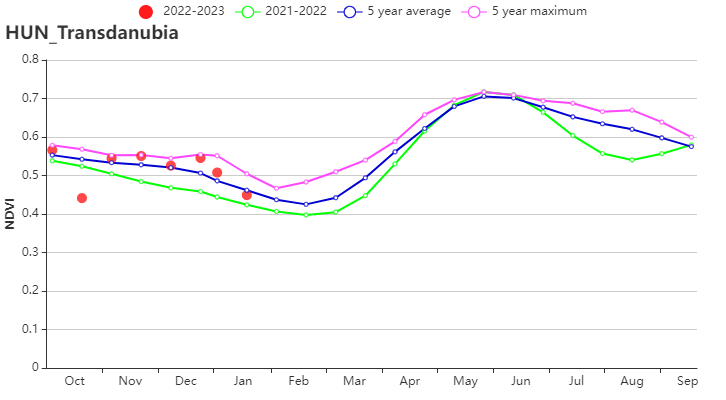
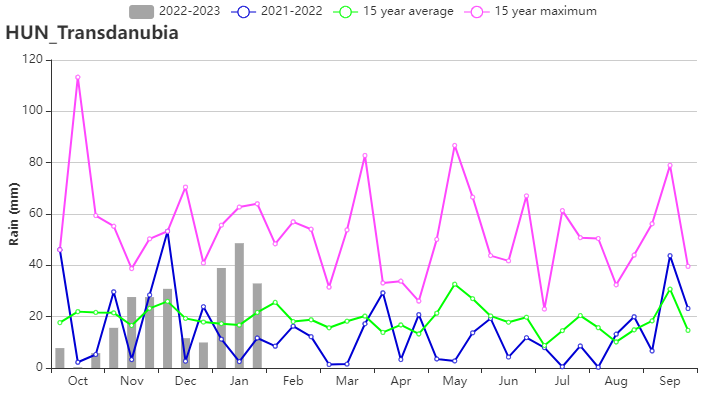
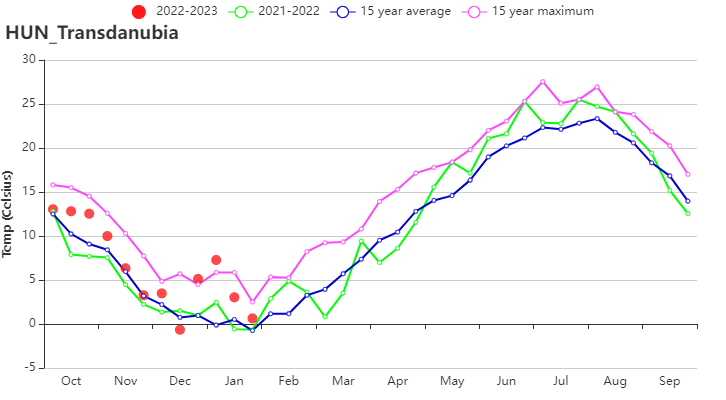
(h). Crop condition development graph based on NDVI, RAIN and TEMP (Transdanubia).
Table 3.27 Hungary's agronomic indicators by sub-national regions, current srason's values and departure from 15YA, October 2022-January 2023
| Region | RAIN | TEMP | RADPAR | BIOMSS | ||||
| Current(mm) | Departure from 15YA(%) | Current(°C) | Departure from 15YA(°C) | Current(MJ/m2) | Departure from 15YA(%) | Current(gDM/m2) | Departure from 15YA(%) | |
| Central Hungary | 203 | -8 | 6.5 | 2.2 | 335 | 0 | 481 | 4 |
| Puszta | 222 | -7 | 7.0 | 2.3 | 342 | 1 | 506 | 6 |
| North Hungary | 222 | -2 | 5.5 | 2.1 | 308 | -1 | 477 | 7 |
| Transdanubia | 258 | 7 | 6.4 | 2.0 | 342 | -2 | 553 | 15 |
Table 3.28 Hungary's agronomic indicators by sub-national regions, current season's values and departure from 5YA, October 2022-January 2023
| Region | CALF | Maximum VCI | |
| Current(%) | Departure from 5YA(%) | Current | |
| Central Hungary | 99 | 6 | 1.05 |
| Puszta | 99 | 17 | 1.01 |
| North Hungary | 100 | 10 | 1.04 |
| Transdanubia | 99 | 4 | 0.94 |
